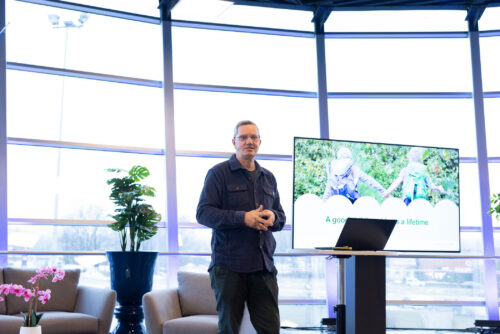
News
The key to success in Scandinavian pedagogy is the acknowledgment of a child’s needs and desires
Hans Jacob Sundby (Norway), the founder of the preschool network “Dibber” (known as “CreaKids” in Latvia)
The Scandinavian pedagogical approach in Latvian preschools is often cited as an example of best practice. However, the key to success is straightforward – it is essential to recognize and listen to each child’s wishes and needs, provide opportunities for learning through play, create a safe environment, and help children understand that learning can also come from mistakes.
Unfortunately, I have seen preschools where two-year-olds sit motionless with their hands folded on the table while the teacher stands at the board and points to what is written with a pointer. If two-year-olds sit like this during the learning process, it is likely due to fear, which certainly does not aid the learning process. Yes, children may memorize what is written on the board or in books in this way, they will likely learn it by heart and answer when asked, but will they understand it? Scandinavian pedagogy from the preschool stage emphasizes that understanding is essential and underscores that every child should have the opportunity to express themselves. Therefore, we encourage children to think for themselves and understand what they have learned, not just repeat what the teacher says. Another characteristic of our pedagogy is that preschool-aged children learn using all their senses and surroundings. They explore the world through sensations and sensory experiences: playing, going for walks, playing games, etc.
80% of brain development occurs in the first 5 years.
One of the most important elements of quality preschool education is a safe environment – both physically and emotionally. The environment in which a child finds themselves in their preschool years largely determines whether they will grow up with an attitude of “I can” or “I cannot”. There are people who are always ready to learn something new, who may not know one thing or another but are willing to try; usually, such people also attract others. And there are those who will respond “I cannot,” “I don’t like it” to almost any suggestion and are not willing to try anything new. The group to which a person belongs is most often determined in the first five years of life when 80% of brain development occurs, and it is very difficult to change in later stages of life. Adults often spend years seeing therapists to overcome the limitations of their childhood. It is in the first five years that the openness of a child to learning new things is developed, with what desire and motivation they will want to learn in the future.
Working in preschool is not suitable for everyone.
Another essential factor in quality preschool education is the relationship between the number of children and the number of educators. However, it is not just about the numbers but also about the ability to collaborate with children. It may sound harsh, but I believe that if you want to work in preschool, you must love children. This is not a job that can be done just because money is needed. I have spoken to people who say they had a choice – to work in a store and stock shelves or work in a preschool with children, and they chose preschool. In such cases, however, I encourage them to go and work in the store – people who do not see the difference between these two jobs should not work with children. This job is not for everyone; it is for those who are ready to create a safe environment for children and build trusting relationships.
Children are very smart and can sense the thoughts with which an adult approaches them. At the same time, new colleagues come to us from various places, including from the aforementioned store or other fields, the main thing is that a person has a desire to help children. With each potential colleague, we have long conversations during which we understand whether our values match. The first person who applies for a job should not always be chosen, even if there is a shortage of educators at the time. Returning to the relationship between the number of children and educators, of course, there must be a sufficient number of educators to create the necessary environment and devote enough attention to each child. Some educators immediately find a common language with children and can create the necessary atmosphere.
The most important task is to provide an appropriate environment.
Everything I have learned about the importance of preschool education has been accumulated for over 20 years, and I continue to improve my knowledge constantly. We took the first steps in the field of preschool education in 2002, but now we work in 10 countries – more than 600 preschools on 3 continents, which unite 30,000 employees and 45,000 children. When we opened the first preschools, we saw the choices parents had to make – on the one hand, circumstances often force them to return to work quickly, on the other hand, there are concerns and worries about how the child will feel. Regardless of the age at which a child starts preschool (in Norway, from about ten months old, in Finland from one year old, in the UAE from four months old, etc.), our most important task is to provide a suitable environment – safe, comfortable, peaceful, and creative. Unfortunately, after 20 years of working in preschool education, we have also seen situations where preschool is the only place where a child can feel safe, which only increases awareness of the importance of this stage of education.

 Log In
Log In